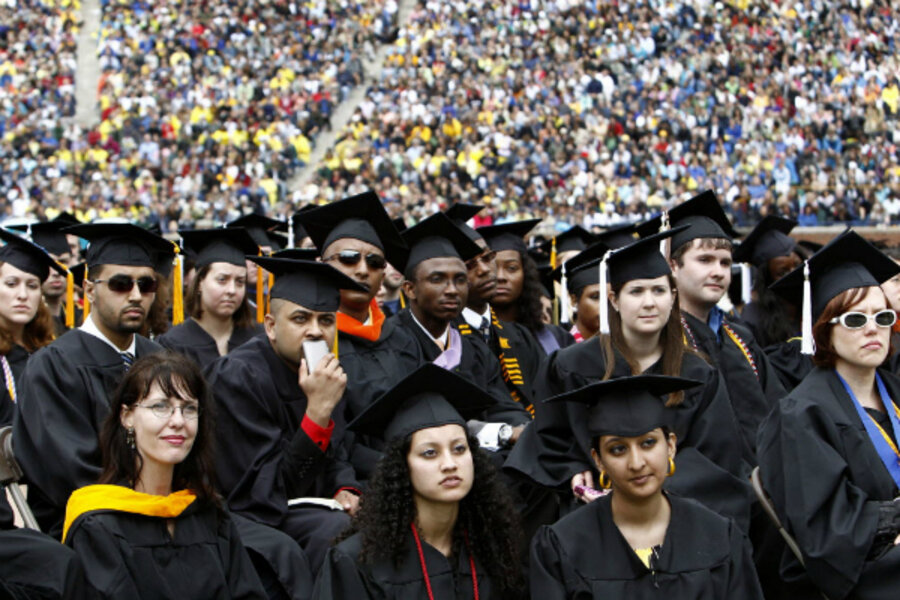How tougher classes in high school can help kids make it through college
Loading...
About 4 out of 10 students at four-year colleges fail to earn a degree within six years – and timely completion rates at two-year schools are even lower.
But what if high schools had a better recipe for preparing their students to stay in college? The National School Boards Association released a study Thursday afternoon highlighting some key ingredients: more advanced math courses, challenging courses such as Advanced Placement (AP) and International Baccalaureate (IB), and better academic advising.
If students are exposed to those factors – even if they don’t earn high scores on the course exams – they are more likely to continue college after their first year, a point at which many drop out, the study notes.
“This provides a rare glimpse into what high schools can do to really improve college success,” said Jim Hull, senior policy analyst at NSBA’s Center for Public Education, in a teleconference with reporters Thursday.
The findings don’t provide a silver bullet for school districts – many of which are still debating whether to make higher math mandatory or to open up college-level AP courses to all students who are interested.
“There’s certainly a big correlation between students in high school who take advanced math and [those who] do well in college, but correlation is not cause and effect; it could very well be that the people whose future destiny is to do well in college also are good at doing math,” says David Klein, a math professor at California State University at Northridge who has studied AP math courses and found many of them to lack quality when compared with college courses.
But by providing details about how students from various achievement levels and socioeconomic backgrounds fare in college, NSBA’s study attempts to control for as many factors as possible in order to isolate elements that high schools can improve.
The study is based on data from more than 9,000 students who enrolled in college immediately after high school in the fall of 2004 – a sample that represents more than 2 million students nationwide.
Among the findings:
- Higher-level math: Algebra II is the highest level of mandatory math in many high schools, Mr. Hull said. But if the high school students took pre-calculus or calculus, rather than stopping at Algebra II, their likelihood of staying in a four-year college past the first year (“persistence”) increased by a range of 10 to 22 percent (10 percent for students who already had above-average achievement and socioeconomic backgrounds and 22 percent for those who were below average). Persistence in two-year colleges was 18 to 27 percent higher.
- AP/IB courses: Participation in these courses increased four-year students’ college persistence by 7 to 17 percent, again with the higher figure for students who had lower academic achievement prior to taking AP or IB. The impact in two-year colleges was 17 to 30 percent higher. The more of these courses they took, the more their likelihood to persist in college increased. “There are still some people out there who believe that providing students with a course that might be over their head might be detrimental to their academic success,” Hull said. “However, this study provides one strong indicator … that providing all students with a rigorous curriculum helps students succeed.”
- Academic advising during the first year of college. The study found that 11 percent of four-year college students and 25 percent of two-year students had never talked with a college academic adviser. For four-year college students from lower-achieving, lower-socioeconomic backgrounds, those who saw an academic adviser often were 53 percent more likely to persist than those who saw one never. At two-year colleges, the difference was 43 percent. The need for investing in better advising trickles down to high schools, where the national ratio of students to guidance counselors is about 500 to 1, Hull says.
The NSBA report isn’t the first call to expand access to more challenging courses. Since 1998, for instance, The Washington Post's Jay Matthews has been ranking high schools for how well they prepare students for college, based on a Challenge Index that takes into account AP and IB courses.
The National Math and Science Initiative’s Advanced Placement program, which includes open enrollment in the courses in participating schools, has trained more than 11,000 teachers to help bolster students’ preparation for college. In 2011-12, the 70 schools that newly joined the initiative doubled the number of qualifying scores students achieved on math, science, and English AP exams. That included a doubling of qualifying scores for Hispanics and tripling of such scores for African-Americans.
“Many people often overlook students such as myself since I come from a lower socioeconomic background/single parent household,” writes Rudy Davis – a junior at Auburn University in Alabama, who attended an Alabama high school with the NMSI AP program – in a blog entry.
“Through this program I saw my standardized test scores improve from 68th percentile to 97th percentile. And my math and science score rose to the 99th percentile…. The AP curriculum has more than prepared me for my current college course work. I gained credit hours, the work ethic needed to do well, confidence in my intellect, and as a result, have made the Dean’s list in college.”








